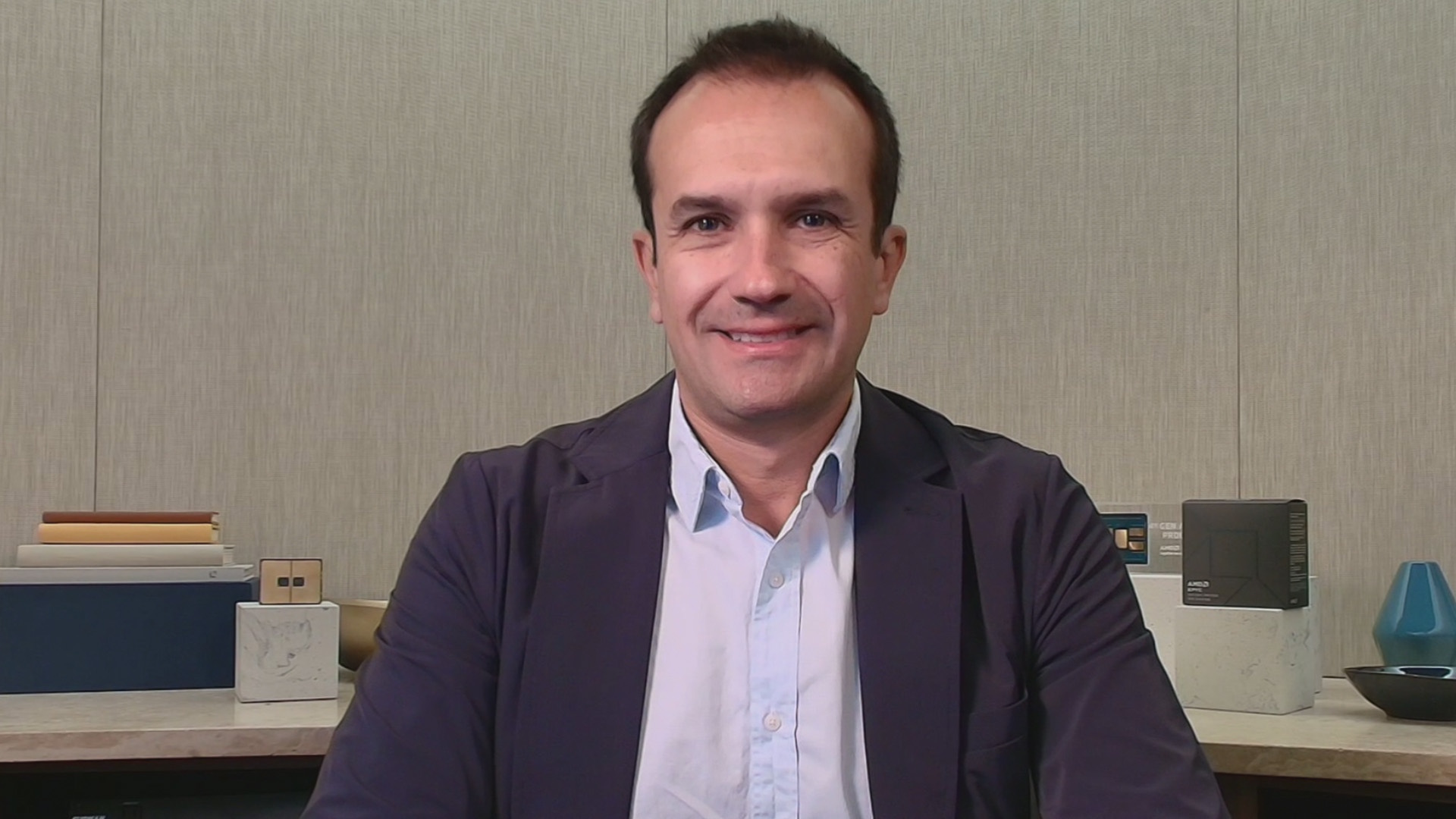The modernization mandate is clear: Enterprise IT can no longer wait. Disruptive workloads and brittle legacy systems are forcing companies to act fast, with many now searching for tools that can support a next-generation AI architecture and redefine the data center.
The nearly 20-year alliance between Dell Technologies Inc. and Advanced Micro Devices Inc. has become a key architectural answer to this shift. Once foundational, the partnership now centers on next-generation AI architecture and private cloud strategy — areas where modernization is no longer optional. The stakes are binary, according to Juan Martinez (pictured), senior director of OEM/ODM enterprise and HPC at AMD.
TheCUBE Research’s Rob Strechay talks about the Dell and AMD partnership during the “5 Steps to a Smarter Private Cloud” event.
“Our customers, regardless of the industry … are facing two potential outcomes,” Martinez told theCUBE. “One outcome is [to] be a disruptor in their industry, which will be great for them, or be disrupted by someone else.”
Dell and AMD’s shared focus on efficiency and cost resonates with enterprise buyers. Their integrated approach offers a stable alternative to unpredictable public cloud expenses and tackles core pain points, according to Rob Strechay, principal analyst at theCUBE.
“I think that one of the things that’s really interesting is … that not only helps from a density perspective, power and cooling, but also licensing costs when you’re looking at software that are licensed that way,” Strechay said during the recent “5 Steps to a Smarter Private Cloud” event. “We see it from the … organizations we talk to on a daily basis.”
This feature is part of News Media’s ongoing exploration into enterprise modernization and next-generation infrastructure ecosystems. (* Disclosure below.)
Silicon optionality drives density and total cost of ownership for private cloud
While AI’s growing influence drives enterprise modernization, Dell and AMD’s real-world impact is already visible in the budget. Their joint solutions are delivering measurable cost relief to IT teams today. Dell’s broader approach to silicon optionality — offering customers a choice between AMD, Intel Corp. and Nvidia Corp. — allows organizations to match the right performance and price-per-watt profile to each unique workload, according to theCUBE’s Dave Vellante.

AMD’s Juan Martinez talks with theCUBE about the AMD-Dell partnership.
The joint engineering between Dell PowerEdge and AMD’s EPYC processor line is designed to tackle two major pressures: rising AI compute demands and the need to extend the value of existing infrastructure, thereby enabling the next-generation AI architecture, according to Martinez. The strategy is especially effective in virtualized environments, where maximizing server output is key to reducing overall infrastructure sprawl.
“When we look into what we are offering between Dell PowerEdge and our AMD EPYC portfolio, basically we are getting that customers are able to run a larger number of virtual machines per server versus what they used to do in the past,” Martinez told theCUBE. “They are able to get up to 192 cores of performance, high memory bandwidth, and on top of that, we are able to bring a comprehensive path for migration.”
This emphasis on efficiency isn’t just theory. Dell and AMD currently hold two world records for VMware performance per socket, highlighting their ability to drive greater density, smarter power management and stronger cost efficiency, according to Martinez. Early customer results back it up: Some have reduced hardware usage by as much as 90%, unlocking the budgetary freedom to focus more on innovation.
“AMD EPYC is basically putting all the higher core count, the high memory bandwidth, and that is putting all the comprehensive path to manage all the transition in a way that is making sense from a technical standpoint and AMD standpoint,” Martinez said. “We’re working with Dell very actively to have co-engineering tools that help them to have a comprehensive path to maximize their private clouds and the solutions that they’re running in those private clouds.”
Co-engineering optimizes performance and sustainability with next-generation AI architecture
As AI workloads become more varied and distributed, system designers are shifting away from monolithic architectures toward balanced, co-engineered infrastructure to support next-generation AI architecture. Dell and AMD’s collaborative approach to building PowerEdge systems with AMD’s Turin family tailors configurations to support AI deployments of all sizes — not just the largest hyperscale use cases, according to David Schmidt, senior director of PowerEdge product management at Dell, and Derek Dicker, corporate vice president, enterprise and HPC business groups at AMD.

Dell’s Alyson Langon and Alison Briers talk with theCUBE about the Dell and AMD partnership.
“When we sat down and first started discussing Turin with AMD, we recognized that there’s different sizes for different parts of customer journeys, what they need to deploy in their data center,” Schmidt told theCUBE. ”We looked at how AMD was laying out Turin, the Turin stack from top to bottom, and we really challenged each other on what we needed to provide. We were bringing system design ideas to the table of serving customers that need eight cores, 16 cores. It’s not all about the highest core counts possible; it’s about providing the right range.”
As hardware density and core counts increase, the pressure on power and cooling infrastructure becomes a key design constraint. This demand is driving a shift back to on-premises control, with customers seeking to avoid high variable costs and gain predictable total cost of ownership, according to Alyson Langon, director of product marketing at Dell, and Alison Biers, global marketing senior director for server, networking and vertical industries at Dell.
“[Customers] need predictable [total cost of ownership] so that they can have better budget control,” Briers told theCUBE. “They also want to avoid vendor lock-in with a modular, open infrastructure that can provide that ease of portability, as well as flexibility, and they really want to keep control of their data. They need to keep that data local and secure for stronger compliance and security … they need visibility to the future costs, and they want to … have that across their organization, whether it comes from departments within their organizations or from IT.”
Dell’s AI Factory turns partnership into production power
Dell’s updated AI Factory architecture is designed to meet enterprises where they are — whether starting small with device-level AI or scaling into full multi-rack deployments. With support for multiple accelerator vendors, the platform enables organizations to choose the right hardware configuration for their workloads without lock-in. This flexibility allows enterprises to evolve from early pilots to mature, production-scale AI faster and with lower risk, according to Adam Glick, senior director of AI portfolio marketing at Dell.

Dell’s Adam Glick talks with theCUBE about the Dell AI Factory.
“The AI transformation that we’re seeing is really a Cambrian explosion,” Glick told theCUBE. “You’re talking about the people who are on the forefront or not. You need to avoid being left behind because what you can do with AI is just amazing.”
The platform’s modular design is backed by a rigorously tested stack of hardware, networking and software components, including Dell’s Application Catalog, support for Hugging Face Inc.’s open-weight models and optimized on-premises deployment workflows. For companies managing infrastructure complexity and resource constraints, Dell’s emphasis on validated, full-stack solutions — in collaboration with partners such as AMD and Red Hat Inc. — simplifies rollouts and accelerates time-to-value for the next-generation AI architecture.
“There’s a lot of work that’s gone together to integrate these two pieces,” Glick said. “It’s not just the hardware pieces and the machines that go together, but it’s also the networking and the software stack, [which is] tested, integrated [and] optimized to be able to deploy that and deploy it fast and at scale to deliver solutions that our customers are looking for.”
The operational reality of running an AI Factory hinges on addressing siloed, fragmented data, which Dell solves with its AI Data Platform. A critical feature of this platform is the architectural decoupling of data storage (leveraging Dell PowerScale and ObjectScale) from data processing engines, eliminating bottlenecks and providing the essential flexibility for advanced AI workloads such as retrieval-augmented generation and next-generation AI architecture. This modular, open-architecture approach empowers organizations to move from AI pilots to full production faster and with reduced risk, according to Travis Vigil, senior vice president of ISC product management at Dell.
“With our Dell AI Data Platform, storage engines and data engines are each optimized for what they do best, working together, but independently,” Travis said during an interview with theCUBE. That means no bottlenecks, no lock-in — just the freedom to innovate on your terms. By separating data processing from storage, we eliminate friction and reduce solution costs.”
Together, Dell and AMD are proving that modernization isn’t just about new technology — it’s about giving enterprises the architectural freedom to innovate at their own pace, according to Strechay.
(* Disclosure: TheCUBE was a paid media partner for the “5 Steps to a Smarter Private Cloud” event. Neither Dell, the sponsor of theCUBE’s event coverage, nor other sponsors have editorial control over content on theCUBE or News.)
Photo: News
Support our mission to keep content open and free by engaging with theCUBE community. Join theCUBE’s Alumni Trust Network, where technology leaders connect, share intelligence and create opportunities.
- 15M+ viewers of theCUBE videos, powering conversations across AI, cloud, cybersecurity and more
- 11.4k+ theCUBE alumni — Connect with more than 11,400 tech and business leaders shaping the future through a unique trusted-based network.
About News Media
Founded by tech visionaries John Furrier and Dave Vellante, News Media has built a dynamic ecosystem of industry-leading digital media brands that reach 15+ million elite tech professionals. Our new proprietary theCUBE AI Video Cloud is breaking ground in audience interaction, leveraging theCUBEai.com neural network to help technology companies make data-driven decisions and stay at the forefront of industry conversations.








